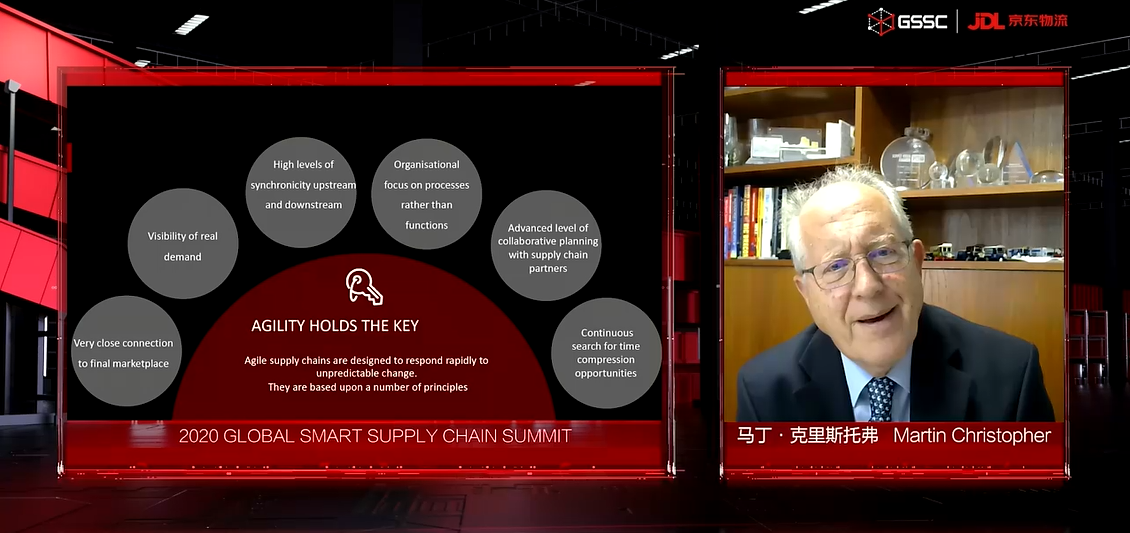Oct 22, 2020|
GSSC Series: Uncertainty can Represent Opportunity for Agile Companies
by Kelly Dawson
Companies that are able to capitalize on the opportunities presented by upheaval and uncertainty are the ones who will be the long-term winners in the global supply chain industry, said Martin Christopher, emeritus professor of marketing and logistics at Cranfield School of Management, United Kingdom.
Speaking during JD’s Global Supply Smart Supply Chain Summit (GSSC) on October 22nd, Christopher said that many companies have been caught unprepared for the disruption presented by the pandemic.
“This has never been a more challenging time,” he said. “It doesn’t matter what industry we are in or which part of the world we work in, global supply chains are having to be re-evaluated and reassessed.”
He described current conditions with the acronym VUCA: Volatility in the market; Uncertainty about the future; Complexity in the links of the global supply chain; and Ambiguity in analyzing current conditions.
In order to succeed in these conditions, companies must be agile, he said.
“Companies who are most likely to succeed in today’s world are those companies who are faster on their feet,” he said. “They can make decisions quickly, they can change direction quickly, they don’t have investments which have been made some years ago in brick-and-mortars [that] they can’t change.”
One of the critical elements to being more agile is staying extremely close to the market in order to see it more clearly, he said. A successful company “reads what’s happening not just day-by-day, but hour-by-hour— and new developments in information technology are making it possible for us to do this.”
These companies are also “sharing that information upstream and downstream so that we can synchronize across our supply chain so we’re all marching to the same drumbeat. Supply chains have their forecasts, we [as analysts] have our forecasts, and our customers have a different forecast.”

For JD, agility is baked directly into the corporate strategy—and data plays a significant role in realizing that vision. For example, during the spike in online shopping in the early months of the pandemic this year, JD Logistics immediately increased inventory in warehouses across the country based on consumption big data, to ensure smooth, fast delivery. In fact, despite the pandemic most customers still enjoyed same- or next-day delivery.
When Wuhan went into lockdown earlier this year, JD quickly deployed logistics staff and introduced automated delivery robots to minimize human contact during deliveries, ensuring the safety of both customers and JD couriers.
JD has also implemented the “Big Boss” approach, which delegates decision-making power to the managers of various districts and divisions. The thinking behind this strategy is that these lower-level “big bosses” are in fact best equipped to make decisions related to their work, as they are closest to the customers. Eliminating the need for multiple layers of top-down approval has made the company more agile in responding to customer demand—ultimately the most important aim of an agile approach.
Ultimately this kind of strategy will prepare a company to take advantage in times of uncertainty, Christopher said.
“It’s not just about the downside of risk, it is also about the upside of risk,” he said. “If we can prepare ourselves as companies and organizations to take advantage of that upside, we could indeed be the winners.”
Christopher’s comments came amidst the fifth GSSC summit, which is an annual event focused on logistics innovation and technology communication on a global scale, hosted by JD Logistics. Under this year’s theme of “Open Capabilities, Shared Growth”, the GSSC gathered the world’s leading experts in the industries of logistics, commerce, science and technology to discuss how to seize the opportunities provided by the macro environment and policy, with an aim to reshape the industrial supply chain and promote high-speed growth.




 Who is JD.com?
Who is JD.com?



